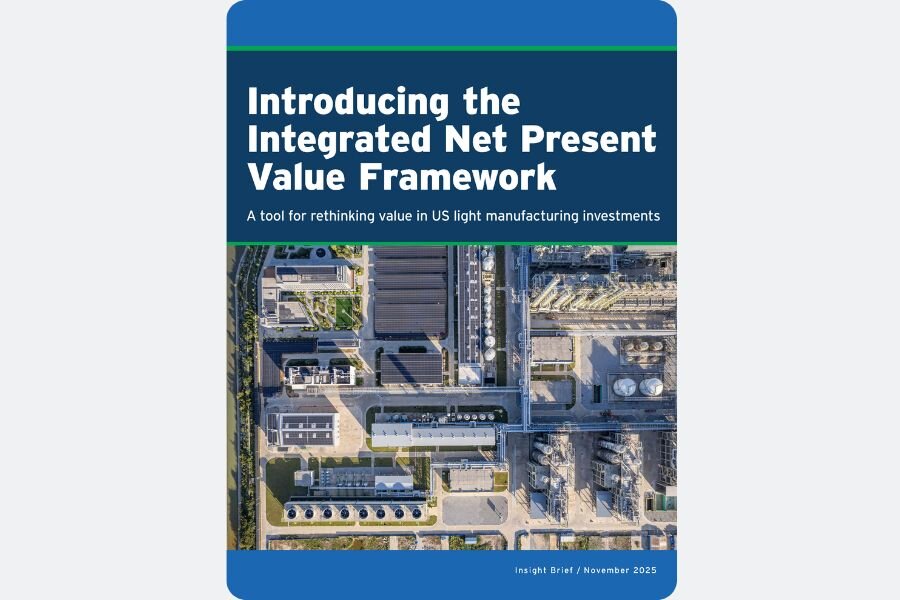Introducing the integrated Net Present Value framework
- By Valeriya Azarova, Nabil Bennouna, Megan Gross, Thomas Alan Kwan, Silvia Madeddu, & Corey Stewart
- 17 Nov 2025
- 5 min
U.S. light manufacturing is at a turning point. Energy volatility, workforce constraints, and rising sustainability expectations are pushing executives to rethink facility operations. Yet many companies underinvest in transformative solutions — not because the technology isn’t ready, but because traditional financial tools undervalue the full strategic benefits these upgrades deliver.
A new framework from RMI and the Schneider Electric Sustainability Research Institute helps close this gap. The Integrated Net Present Value (iNPV) framework offers a fuller picture of value creation, quantifying benefits that standard cost-benefit analyses routinely overlook.
Conventional NPV calculations focus on direct cost savings such as energy efficiency and reduced maintenance. While useful, this narrow view misses critical value streams modern investments generate.
Traditional approaches overlook risk mitigation benefits like protection against fuel price swings, improved reliability, and enhanced supply chain resilience. They also neglect emerging revenue opportunities from demand response and grid services, as well as market differentiation drivers including sustainability premiums and regulatory risk hedging.
Executives increasingly recognize these benefits, yet lack a quantitative framework to justify them. Nearly nine in ten North American companies view sustainability investments as value creation opportunities, but existing tools rarely reflect that reality.
The iNPV framework integrates operational flexibility, risk mitigation, and market differentiation into quantified, cash-flow-aligned metrics tailored to light manufacturing.
iNPV doesn’t replace NPV — it augments it. Benefits once considered intangible become measurable inputs for investment decisions. The framework provides practical metrics manufacturers can apply using readily available data.
Operational Flexibility
- Energy efficiency savings
- O&M reductions from fewer moving parts and less downtime
- Demand response and load management revenues
Risk Mitigation
- Reduced exposure to volatile natural gas prices
- Reliability from distributed energy resources and storage
- Safety and insurance benefits
Market Differentiation
- Consumer sustainability premiums
- Scope 3 attribute monetization
- Regulatory hedging against future carbon costs
To show how the framework works, researchers modeled a typical U.S. dairy processing facility. They compared traditional NPV results with iNPV outcomes across electric boilers, heat pumps, automation, and behind-the-meter solar plus storage.
Traditional NPV produced roughly $1.3 million in value. Using the iNPV framework, the same upgrades generated $3.6–$3.8 million — nearly triple the traditional estimate.
Automation delivers limited value under conventional models but generates more than $1 million in iNPV due to improved reliability, safety, and uptime. Behind-the-meter solar and storage similarly shift from modest investments to nearly $1.9 million in strategic value once grid services revenue and resilience are included.
Heat pumps show strong performance in both frameworks. Electric boilers become attractive in regions with cleaner electricity or when paired with on-site renewables.
Most importantly, integrated upgrades create far greater returns than evaluating components individually — the compounding benefits of electrification, automation, and distributed energy resources are missed entirely under traditional methods.
Manufacturers face rising energy costs, tight labor markets, growing sustainability expectations, and evolving climate policy. Without better evaluation tools, companies may underinvest in capabilities essential for competitiveness over the next decade.
The iNPV framework reveals that while electrification alone may not always pencil out using conventional metrics, electrification paired with automation and on-site renewables delivers substantial, durable value.
It also helps finance teams and boards gain confidence in long-term investments and enables manufacturers to prioritize technologies based on the value streams most relevant to their operations and regions.
Apply holistic assessments
Use frameworks like iNPV to quantify operational flexibility, risk mitigation, and market differentiation — not just energy savings.
Target electrification sweet spots
Focus on processes with high compatibility, typically sub-500°C heat applications and cooling.
Evaluate systems, not components
Integrated solutions usually produce higher returns than isolated upgrades.
Engage regionally
Join coalitions to share data, pilot solutions, and advocate for supportive policies in regions such as the Midwest, California, and Texas.
Upgrade data infrastructure
Tracking new value streams requires better digital systems for reliability metrics, grid services participation, and sustainability attributes.
The iNPV framework represents a needed shift in how manufacturers evaluate transformation investments. As energy systems evolve and competitive dynamics change, the companies that excel will recognize value in all its forms.
Traditional NPV suited an era of stable energy prices and predictable regulation. Today, decision makers need tools that quantify resilience, strategic positioning, and sustainability leadership. The economic opportunity is significant — and the technologies are ready. The iNPV framework provides a practical pathway to capture this value and build long-term competitiveness in a rapidly evolving industrial landscape.
See how manufacturers can unlock millions in hidden value using the Integrated Net Present Value framework. Get the full report for the complete analysis.

Latest from the Sustainability Research Institute
Time to power: A generational cycle of modernization in the US
Introducing the integrated Net Present Value framework
Original insights on the decarbonization potential of Brazil through innovation
Demand-pull policy framework for emission intensive industries


